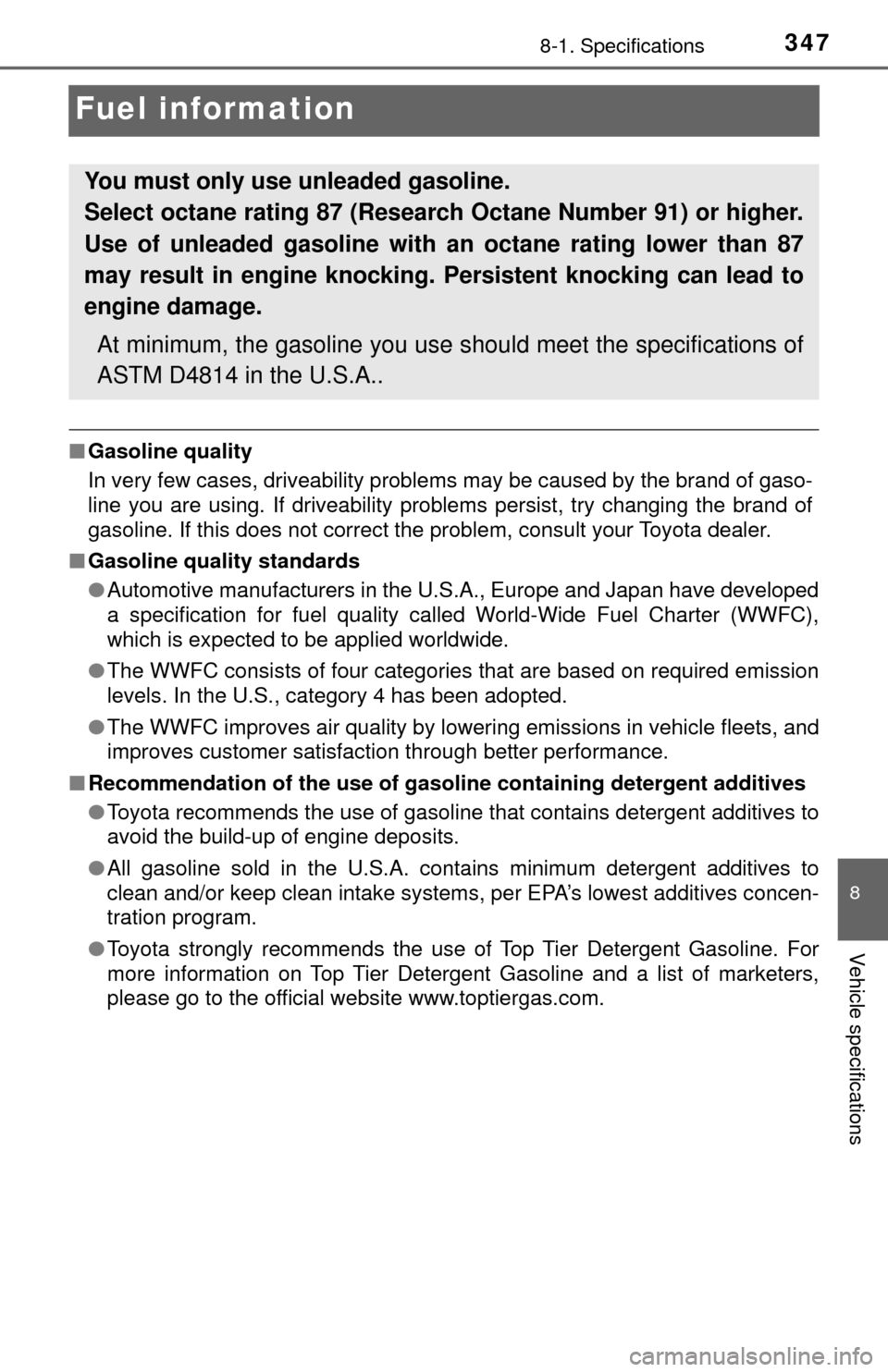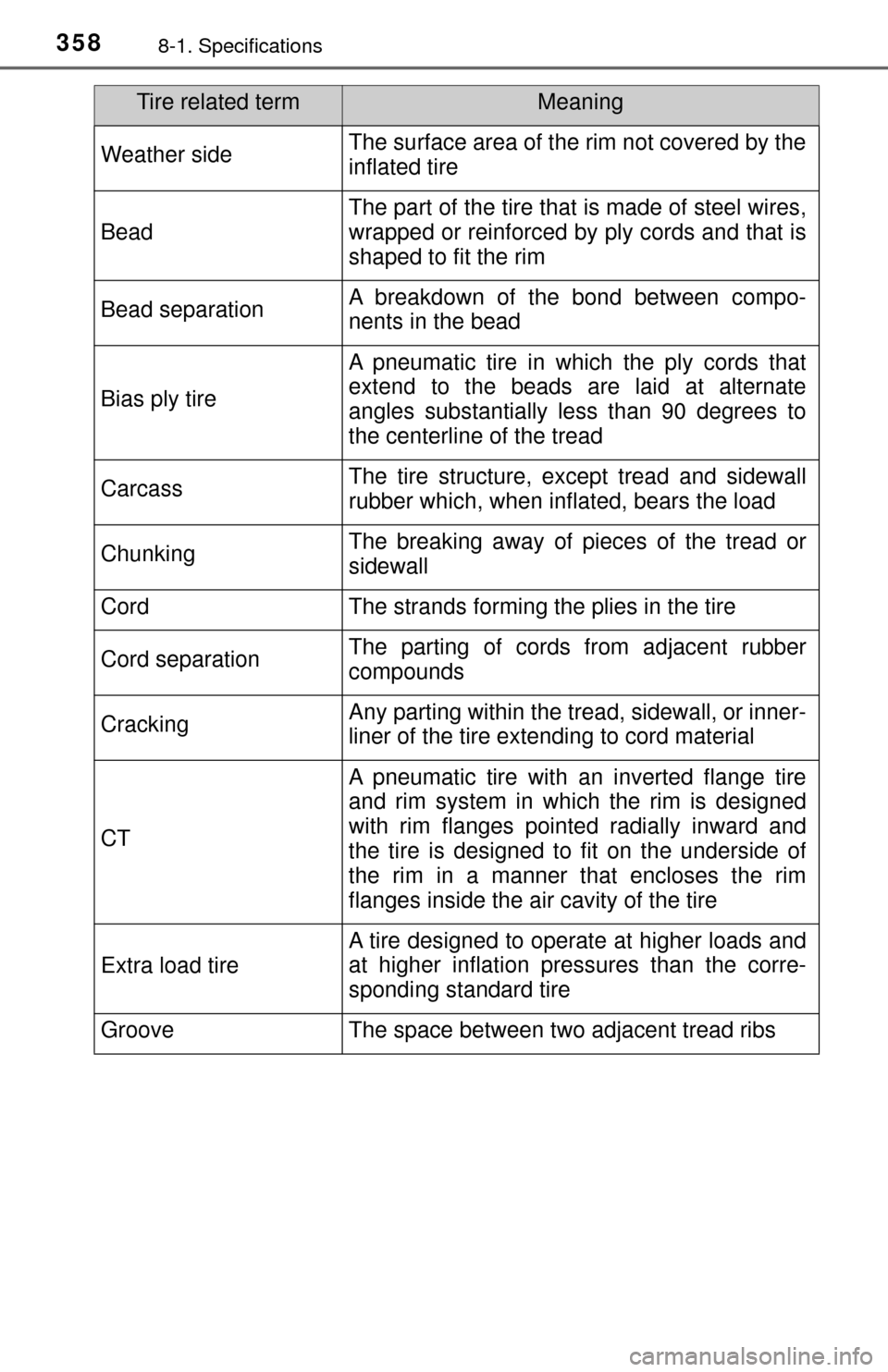Page 347 of 396

3478-1. Specifications
8
Vehicle specifications
Fuel information
■Gasoline quality
In very few cases, driveability problems may be caused by the brand of gaso-
line you are using. If driveability problems persist, try changing the brand of
gasoline. If this does not correct the problem, consult your Toyota dealer.
■ Gasoline quality standards
●Automotive manufacturers in the U.S.A., Europe and Japan have developed
a specification for fuel quality called World-Wide Fuel Charter (WWFC),
which is expected to be applied worldwide.
● The WWFC consists of four categor ies that are based on required emission
levels. In the U.S., category 4 has been adopted.
● The WWFC improves air quality by lowering emissions in vehicle fleets, and
improves customer satisfaction through better performance.
■ Recommendation of the use of gaso line containing detergent additives
● Toyota recommends the use of gasoline that contains detergent additives to
avoid the build-up of engine deposits.
● All gasoline sold in the U.S.A. contains minimum detergent additives to
clean and/or keep clean intake systems, per EPA’s lowest additives concen-
tration program.
● Toyota strongly recommends the use of Top Tier Detergent Gasoline. For
more information on Top Tier Detergent Gasoline and a list of marketers,
please go to the official website www.toptiergas.com.
You must only use unleaded gasoline.
Select octane rating 87 (Research Octane Number 91) or higher.
Use of unleaded gasoline with an octane rating lower than 87
may result in engine knocking. Persistent knocking can lead to
engine damage.
At minimum, the gasoline you use s hould meet the specifications of
ASTM D4814 in the U.S.A..
Page 351 of 396

3518-1. Specifications
8
Vehicle specifications
Tire size (→ P. 352)
DOT and Tire Identification Number (TIN) (→ P. 352)
Location of treadwear indicators (→ P. 253)
Tire ply composition and materials
Plies are layers of rubber-coated parallel cords. Cords are the strands
which form the plies in a tire.
Uniform tire quality grading
For details, see “Uniform Tire Quality Grading” that follows.
Load limit at maximum cold tire inflation pressure ( →P. 257)
Maximum cold tire inflation pressure (→ P. 345)
This means the pressure to which a tire may be inflated.
TUBELESS or TUBE TYPE
A tubeless tire does not have a tube and air is directly put into the tire.
A tube type tire has a tube inside the tire and the tube maintains the air
pressure.
Radial tires or bias-ply tires
A radial tire has “RADIAL” on the sidewall. A tire not marked “RADIAL”
is a bias-ply tire.
Summer tires or all season tires (→ P. 257)
An all season tire has “M+S” on the sidewall. A tire not marked “M+S”
is a summer tire.
“TEMPORARY USE ONLY” (→P. 322)
A compact spare tire is identified by the phrase “TEMPORARY USE
ONLY” molded on its sidewall. This tire is designed for temporary
emergency use only.
1
2
3
4
5
6
7
8
9
10
11
Page 356 of 396

3568-1. Specifications
Glossary of tire terminology
Tire related termMeaning
Cold tire inflation
pressure
Tire pressure when the vehicle has been
parked for three hours or more, or has not
been driven more than 1 mile or 1.5 km under
that condition
Maximum inflation
pressureThe maximum cold inflated pressure to which
a tire may be inflated, shown on the sidewall
of the tire
Recommended
inflation pressureCold tire inflation pressure recommended by a
manufacturer
Accessory weight
The combined weight (in excess of those stan-
dard items which may be replaced) of auto-
matic transmission, power steering, power
brakes, power windows, power seats, radio
and heater, to the extent that these items are
available as factory-installed equipment
(whether installed or not)
Curb weight
The weight of a motor vehicle with standard
equipment, including the maximum capacity of
fuel, oil and coolant, and if so equipped, air
conditioning and additional weight optional
engine
Maximum loaded
vehicle weight
The sum of:
(a) Curb weight
(b) Accessory weight
(c) Vehicle capacity weight
(d) Production options weight
Normal occupant
weight150 lb. (68 kg) times the number of occupants
specified in the second column of Table 1
*
that follows
Page 358 of 396

3588-1. Specifications
Weather sideThe surface area of the rim not covered by the
inflated tire
Bead
The part of the tire that is made of steel wires,
wrapped or reinforced by ply cords and that is
shaped to fit the rim
Bead separationA breakdown of the bond between compo-
nents in the bead
Bias ply tire
A pneumatic tire in which the ply cords that
extend to the beads are laid at alternate
angles substantially less than 90 degrees to
the centerline of the tread
CarcassThe tire structure, except tread and sidewall
rubber which, when inflated, bears the load
ChunkingThe breaking away of pieces of the tread or
sidewall
CordThe strands forming the plies in the tire
Cord separationThe parting of cords from adjacent rubber
compounds
CrackingAny parting within the tread, sidewall, or inner-
liner of the tire extending to cord material
CT
A pneumatic tire with an inverted flange tire
and rim system in which the rim is designed
with rim flanges pointed radially inward and
the tire is designed to fit on the underside of
the rim in a manner that encloses the rim
flanges inside the air cavity of the tire
Extra load tire
A tire designed to operate at higher loads and
at higher inflation pressures than the corre-
sponding standard tire
GrooveThe space between two adjacent tread ribs
Tire related termMeaning
Page 367 of 396
367
9For owners
Reporting safety defects for U.S. owners........................ 368
Seat belt instructions for Canadian owners
(in French) ............................... 369
SRS airbag instructions for Canadian owners
(in French) .............................. 371
Page 371 of 396
371
9
For owners
SRS airbag instructions for Canadian own-
ers (in French)
The following is a French explanation of SRS airbag instructions
extracted from the SRS airbag section in this manual.
See the SRS airbag section for more detailed SRS airbag instruc-
tions in English.
Page 373 of 396
373
9
For owners
Composition du système de coussins gonflables SRS
Coussins gonflables rideau
Capteurs d’impact latéral
(avant)
Coussins gonflables latéraux
Capteurs d’impact latéral
(arrière)
Témoin d’alerte SRS
Coussin gonflable conducteur
Coussin gonflable d’assise de
siège
Contacteur de boucle de cein-
ture de sécurité passager
avant
Prétensionneurs et limiteurs
d’effort de ceinture de sécurité
Capteurs d’impact latéral
(porte avant)Coussin gonflable d’assise de
siège
Contacteur de boucle de cein-
ture de sécurité conducteur
Coussin gonflable de genoux
conducteur
Capteurs d’impact avant
Boîtier électronique de couss-
ins gonflables
Système de classification
d’occupant du siège passager
avant (ECU et capteurs)
Coussin gonflable passager
avant
Témoins indicateurs “AIR
BAG ON” et “AIR BAG OFF”1
2
3
4
5
6
7
8
9
10
11
12
13
14
15
16
17
18
Page 374 of 396
374
Votre véhicule est équipé de COUSSINS GONFLABLES INTELLI-
GENTS (ADVANCED AIRBAGS) conçus selon les normes de sécu-
rité américaines applicables aux v éhicules à moteur (FMVSS208). Le
boîtier électronique de coussins gonflables (ECU) utilise les informa-
tions reçues des capteur s, etc. détaillés dans le schéma ci-dessus de
composition du système pour comm ander le déploiement des couss-
ins gonflables. Ces informations comprennent des informations sur la
gravité de la collision et les occ upants. Le déploiement rapide des
coussins gonflables est obtenu au moyen d’une réaction chimique
dans les dispositifs py rotechniques, qui produit un gaz inoffensif per-
mettant d’amortir le mouvement des occupants.